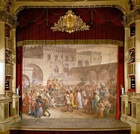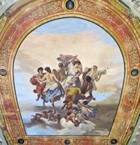Mariano Piervittori was born in Tolentino, but his family moved to Foligno when he was still a child. [More]
Foligno
Frescoes of Sala Consiliare (1884-7)
The Commune commissioned these frescoes for main council chamber of Palazzo Comunale from Mariano Piervittori in 1884. They depict:

-
✴Count Robbacastelli da Foligno, the general of the Milanese army, defeating the Emperor Frederick I at Ponte di Cassano on the River Adda in 1158;
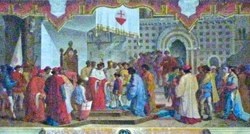
-
✴the arrival of the young Emperor Frederick II in Foligno in 1198;
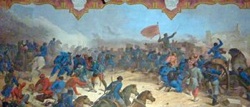
-
✴the death in 1849 of Colomba Antonietti (who had moved to Foligno as a young boy) in the defence of the Roman Republic from the French; and
-
✴personifications, including those of Knowledge, Strength, Prudence and Justice, in the vaults.
Holy Family (19th century)
This altarpiece on the high altar of Santa Margherita is by Mariano Piervittori.
Christ in Glory with Angels (ca. 1855)
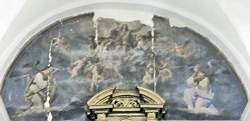
This fresco high on the altar wall of the Oratorio della Misericordia is attributed to Mariano Piervittori.
Bevagna
Dancing muses (ca. 1886)
Orvieto
Frescoes (ca. 1880)
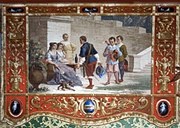
These frescoes in one of the three rooms on the piano nobile of Palazzo Buzi are attributed to Mariano Piervittori. They include this fictive banner, which depicts a scene of a nobleman presenting his regards to two ladies. They also include the coats of arms of the Pallucco and Faina families: Francesco Pallucco and his wife Clelia Faina owned the palace in the period 1877-85.
Perugia
Frescoes (1855-6)
The fresco decoration of the newly-remodelled church of San Simone del Carmine was commissioned from Mariano Piervittori. The scenes include:
-
✴two on the walls:
-
•the angel of Jerusalem; and
-
•St Albert of Jerusalem; and
-
✴in the vault of the nave:
-
•St Simon stock receives a sash from the Virgin; and
-
•five allegories of Virtues (with a sixth by Anton Maria Fabrizi, which was preserved as a record of his work in the church in 1630).
Frescoes (1856)
Ubaldo Baldeschi commissioned the frescoes in the Sala delle Muse of Palazzo Baldeschi Cennini from Mariano Piervittori on the occasion of his marriage to Tecla Balleani; the arms of both families are included in the composition. The main scene records an event at which Braccio Fortebracci sent Matteo degli Ubaldi to Florence as his ambassador to Queen Joanna of Naples in 1420.
Piervittori also executed the frescoes on the ceiling of the adjoining room: it is known as the Sala di Diana e Endimione because the central scene depicts the Goddess Diana looking at the handsome Endymion after Jove has granted her request to send him into eternal sleep so that he would be forever young.
Frescoes (1868)
-
✴angels (in the cupola, one of which is illustrated here); and
-
✴monochrome scenes from the life of St John the Baptist (in the three lunettes).
Unfortunately, they are seriously deteriorated.
Work in Palazzo della Provincia (ca. 1873)
The frescoes of the southern gallery of Palazzo della Provincia are by Mariano Piervittori.
Work in Teatro Morlacchi (1874)
